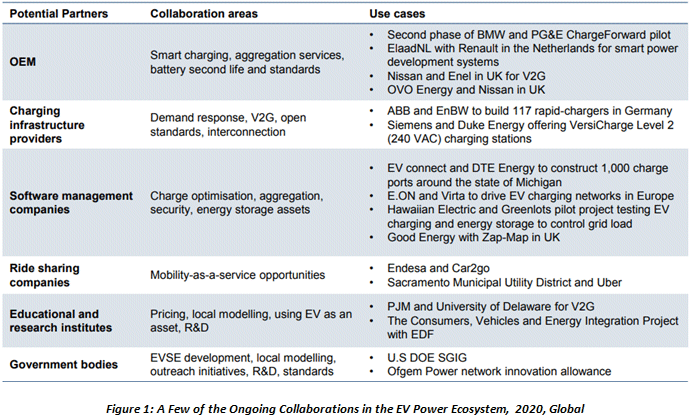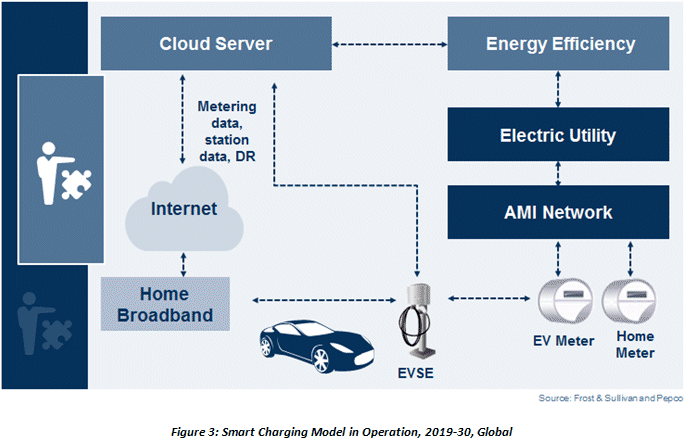We enter the 2020s having watched a number of announcements in the past two years from automakers, power utilities, and private and public transport corporations about partnering and collaborating in the transition to EVs. Cooperation announcements have so far been about smart charging, vehicle-2-grid, mobility as a service, EVs as an asset, and power grid optimization.
Acquisitions by utilities, carmakers and charging infrastructure providers have made the EV power ecosystem a lucrative area to watch. The EV charging solutions market plays a central role in the ecosystem, with seven models currently in different phases of deployment. Each unique model plays a collective role in driving the collaboration between stakeholders. Stakeholders in the EV charging sector include EV manufacturers, battery suppliers, power utilities and infrastructure, EV end users, regulators, external actors, and EV aggregators.
Frost & Sullivan, in its latest research, Future Opportunities in EV Charging, Forecast to 2030, takes a deep-dive into all seven models:
- Battery swapping
- Vehicle to home
- Demand response with EV charging
- Smart charging
- Fast charging
- Wireless charging
- Vehicle to grid
Battery Swapping
Battery swapping works by exchanging an existing battery pack with a newly charged pack at the charging station. The user can come back later to collect his/her old battery pack or can continue to use the new pack. A service fee is charged based on the difference of charge between the old pack and the new. Cell manufacturers, swapping station operators, and electric utilities play a central role in this model. Even though it reduces the amount of time taken to charge an EV to less than a minute, simply by swapping, it poses a layer of complexity at the swapping station as the battery packs need to be charge-ready.
V2X (Vehicle-to-Home and Vehicle-to-Grid)
In liberated energy markets, consumers can play an active role by selling back the excess energy produced to the power grid, accruing monetary benefits at market price. Solar PV has been the most common local energy source used for this purpose. Consumers can sell back the excess energy that their PV panels produce at a fixed rate or store that energy in a battery storage system and sell it back when required. Similarly, with EVs, consumers have the option to sell energy back to the grid and accrue monetary benefits. This functionality has paved the way for two evolving concept markets in EV charging today, Vehicle-2-Grid (V2G) and Vehicle-2-Home (V2H). The former works on the principle that EVs are a usable energy asset and can sell that energy back to the grid when not in use, whereas the latter can use that energy to source power to a household. The adoption of smart electricity meters exposes real-time market prices and can be integrated with EVs for the V2H model. For both V2G and V2H marketplaces to thrive, charging solutions with adequate software support functionalities become necessary. The software solution will act a common interface between the EV, charging station or a household in the case of V2H, and the grid, transferring data back and forth to the solution provider and the user on EV and related information. This includes the amount of charge remaining in the EV, charging station availability, electricity prices and related analysis.
Demand Response with EV Charging
Power utilities play a central role in this model. Knowledge of real-time supply-demand situations and other grid-related events are passed on to the demand response cloud server of the solution provider by the utility. The demand response server and network running on cloud will, in turn, modify the instructions to the EV charging station through its application program interface (API). The instruction is then routed to the software of the charging station, which will then decode and let the owner know if the demand is at peak level. The owner can take preventive action by taking the load off the grid, thus contributing to balancing the grid. The business model can further be made attractive through its combination with the Vehicle-2-Grid (V2G) technology to return the excess power from the EV to the grid; this gives an extra incentive to derive additional revenue and help match the supply and demand.
Smart Charging
Smart charging brings together three critical features. It can help avoid charging during peak demand, increase renewable energy utilization, and provide flexibility to the customers when charging their EVs. The owner, power supplier and charging solutions provider will be required to collaborate in this model.
Fast Charging
Fast-charging solutions that enable EVs to go from a 0% to 100% state of charge within five minutes and that can travel at least 160 km on a single charge are in demand. Fast-charging capabilities will allow the EVs to be more competitive with the alternative technologies such as fuel cell vehicles and increase the business case. A fuel cell car is able to fill up 5 kg of hydrogen at 350 bar within five minutes.
Inductive or Wireless Charging
Inductive charging works on the principle of magnetic induction. The charging plate housing the primary coil in an EV is lowered to transfer energy between the charging plates located on the road. Locations such as bus depots, bus stops, and truck stops are the prominent locations for housing charging plates. Commercial vehicle users have expressed tremendous interest in this model. Over 90% of inductive charging technology developers are focusing on stationary applications; however, after 2020, dynamic charging is expected to be adopted.
Conclusion
Uptake in charging solutions plays a key role in eliminating the anxiety of charging infrastructure availability for EV users. The charging solution’s ease of operation, 24-7 availability, speed of charging, pricing and support for a variety of EVs are crucial to ensure the solution succeeds on a mass scale. Digital support for charging solutions will be a value addition for consumers. Forming partnerships or collaborating with end-supplier utilities, technology solution providers or digital platform providers to maximize the value proposition will play a key role in shaping the charging solutions industry in the 2020s.
Frost & Sullivan, in its latest series of analysis, has released two research reports on EVs: Impact of Electric Vehicles on Power Demand, Forecast to 2040 and Future Opportunities in EV Charging, Forecast to 2030. The focus of the former is to forecast the impact of power demand due to EVs in select geographies and the latter is to outline opportunities arising in EV charging.







